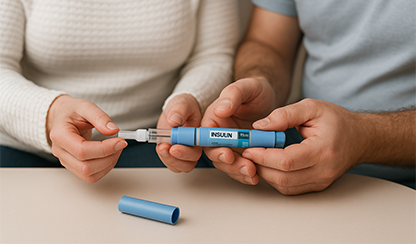26 June 2025
Institute news
Drugs like Ozempic might seem like the latest fad but people can take comfort that this class of medications has been around for decades, writes Dr Natalie Nanayakkara, Endocrinologist and researcher at the Baker Heart and Diabetes Institute.

Medications such as Ozempic, Mounjaro, and Wegovy seem to have exploded onto the market from obscurity in recent years, dominating social media, news segments, and dinner table conversations. Alongside the praise, GLP-1 agents have attracted attention for less positive reasons, including unpleasant side effects, serious health problems and even counterfeits. Hailed as miracle drugs by some, and medications to be wary of by others, many people are unsure whether these medications are truly safe or simply a passing trend. All this hype is enough to make you nervous, and we’re certainly experiencing that apprehension from patients at our clinics. But did you know GLP-1 agonists have been around for 20 years? Originally developed for type 2 diabetes, these medications have a long track record of safety and effectiveness. What’s new, is the increasing awareness of broader health benefits for both people with, and without, diabetes.
What are GLP-1 drugs?
GLP-1 stands for Glucagon-like peptide 1, a naturally occurring hormone that helps regulate blood sugar and appetite after eating. First identified nearly 50 years ago, scientists have since uncovered the crucial role this hormone plays in type 2 diabetes, where levels are often lower or the body’s response to it is impaired. Decades of research eventually led to the development of GLP-1 agonists, medications that mimic the effect of natural GLP-1. Since 2005, when the first GLP-1 medication, exenatide, was approved, the class has evolved with more effective and longer-acting options. These medications have three main actions. They stimulate the pancreas to release insulin (but only when blood sugar levels are high). They slow the transit of food in the stomach, helping people feel fuller for longer after a meal. They act on areas of the brain regulating hunger and fullness, leading to smaller portion sizes, reduced cravings and food noise.
Clinical studies have shown that these medications reduce glucose levels in people with diabetes without the problems of weight gain or risk of low glucose associated with some other diabetes treatments. These medications lead to 10-15% body weight reduction in people with, and without, diabetes. For many people living with obesity, this level of weight loss is not just cosmetic, it reduces the risk of heart disease, joint pain, improves mobility and boosts quality of life. Benefits beyond diabetes and weight loss, include a 30% reduction in the risk of heart attacks and strokes. They also show promise in treating conditions such as fatty liver disease, obstructive sleep apnoea, and kidney disease.
What to expect
Understanding what to expect can make the process easier for anyone considering these medications. Typically, these medications are introduced at a low dose and gradually increased to help the body adjust and minimise the risk of side effects such as nausea, bloating, and constipation. When starting or increasing the dose, one in ten people experience side effects, which usually ease after the first few weeks. Effects on blood glucose levels and weight may take a few weeks to become noticeable and build steadily over time. Regular review with your doctor can help tailor doses, alleviate side effects and monitor your progress safely. More serious but rare risks include pancreatitis (inflammation of the pancreas), eye disease and gallstones. Therefore, it is crucial to have a comprehensive discussion with your doctor to determine if these medications are suitable for you.
Busting the myths
Understanding what to expect can make the process easier for anyone considering these medications. Typically, these medications are introduced at a low dose and gradually increased to help the body adjust and minimise the risk of side effects such as nausea, bloating, and constipation. When starting or increasing the dose, one in ten people experience side effects, which usually ease after the first few weeks. Effects on blood glucose levels and weight may take a few weeks to become noticeable and build steadily over time. Regular review with your doctor can help tailor doses, alleviate side effects and monitor your progress safely. More serious but rare risks include pancreatitis (inflammation of the pancreas), eye disease and gallstones. Therefore, it is crucial to have a comprehensive discussion with your doctor to determine if these medications are suitable for you.
Take care
The rising demand for GLP-1 medications has led to global shortages and, alarmingly, to the emergence of counterfeit versions. This underscores a crucial message: GLP-1s should only be prescribed and dispensed by qualified and experienced healthcare professionals. They are safe, powerful, proven, and life-changing when used correctly.
Cost and access remain barriers for many people to access these medications. Some medications, such as Ozempic and Trulicity, are covered under the Pharmaceutical Benefits Scheme (PBS) for people with type 2 diabetes who meet certain criteria. Others must pay privately, between $150 and $600 a month, depending on brand and dose. Some private health insurance policies cover a small portion of the cost. However, these medications remain out of reach for many who may benefit the most, prompting important conversations about affordability and equity.
GLP-1 medications are a game changer, not a passing fad. Backed by decades of research, they offer new hope to people with diabetes, obesity and many other chronic conditions.
This article has been reproduced with the permission of Diabetic Living Magazine.





